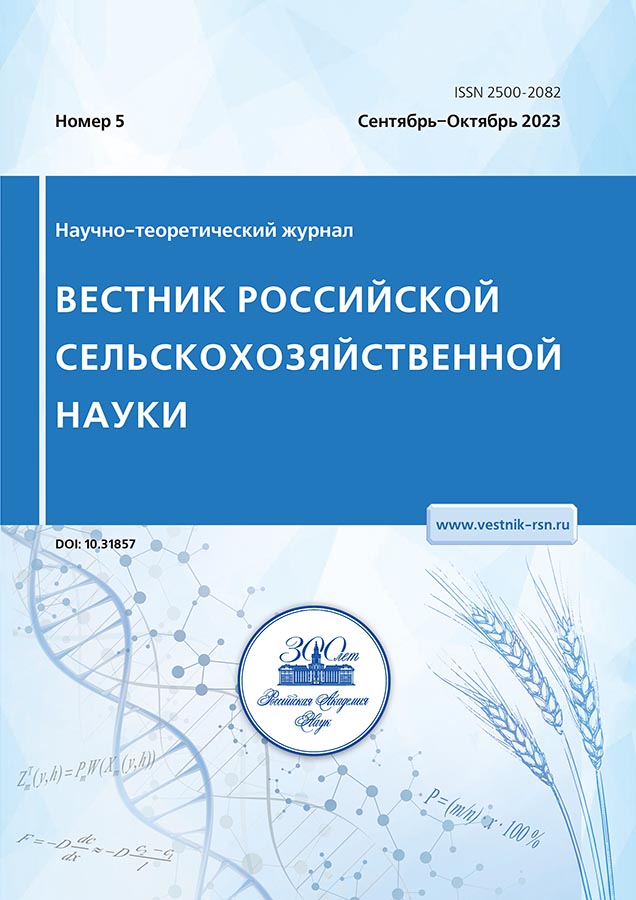EVALUATION OF PERENNIAL POACEAE GRASSES SPECIES AND VARIETIES FOR CREATING LAWNS
Abstract
Under the conditions of the Moscow region, in a field experiment, a comparative assessment of 6 types of perennial grasses and 13 of their varieties was carried out in the lawn mode of use for 12 years. It has been established that in the first year of life, the highest intensity of tillering in the first two to three months was observed in perennial ryegrass, meadow fescue and giant bentgrass. The projective cover of single-species lawns from these species amounted to 92-96% by autumn. In the first year, red fescue was characterized by lower development rates and by the beginning of autumn formed a high-quality lawn with a closed-mosaic structure and 71-79% projective cover, depending on the variety used. The slowest formation of lawns in the year of sowing was noted for meadow bluegrass, which provided projective cover in different varieties from 14 to 60%. The bluegrass lawns reached their maximum density mainly in the third year. The most high-quality lawn with a closed-diffuse composition and 100% projective cover was formed already in the first year when using a grass mixture with the participation of varieties of red fescue, meadow fescue, perennial ryegrass, bent grass, a mixture of meadow fescue, perennial ryegrass and giant bent grass, as well as a mixture of these species with varieties of bluegrass, red fescue and meadow timothy. The best longevity with a high density of shoots and close-diffuse composition with more than 90% annual projective cover for 12 years was distinguished by lawns from red fescue varieties Dipa and Celianna. In polyspecific lawns with the participation of bluegrass meadow, the share of its shoots in the total structure did not exceed 17-38%. Starting from the eighth year, due to the low vegetative mobility of red fescue, there was a consistent increase in the number of bluegrass shoots in the lawn. With intensive constant use of the lawn for sports, the grass mixture with a predominance of up to 90% of bluegrass meadow variety Balin turned out to be the most stable.
References
2. Asyamov V.S., Stepanov A.F., Bondarenko N.A. Mnogoletnie travy dlya sozdaniya gazonov v usloviyah Zapadnoj Sibiri // Vestnik Omskogo gosudarstvennogo agrarnogo universiteta. 2016. № 1 (21). S. 9-14.
3. Bondarenko N.A., Stepanov A.F., Prohorova N.A. Parternye gazony dlya Sibiri // Vestnik Omskogo gosudarstvennogo agrarnogo universiteta. 2016. № 1 (21). S. 15-21.
4. Grechushkina-Suhorukova L.A. Assortiment gazonnyh trav i sostoyanie gazonov v ob"ektah ozeleneniya g. Stavropolya // Izvestiya Timiryazevskoj sel'skohozyajstvennoj akademii. 2022. № 1. S. 12-26.
5. Zolotarev V.N., Perepravo N.I. Agrobiologicheskie osobennosti sortov diploidnoj i tetraploidnoj ovsyanicy lugovoj (Festuca pratensis Huds.) pri vozdelyvanii na semena i gazonnom ispol'zovanii // Adaptivnoe kormoproizvodstvo. 2016. № 3. S. 53–68.
6. Zubarev Yu.N., Subbotina Ya.V., Plastun M.A. Vliyanie normy vyseva i sortov mnogoletnih zlakovyh trav otechestvennoj selekcii na kachestvo gazonov v Srednem Predural'e // Vestnik Bashkirskogo gosudarstvennogo agrarnogo universiteta. 2019. № 1 (49). S. 12-20.
7. Zueva G.A. Biomorfologicheskie osobennosti ovsyanicy lugovoj pri ispol'zovanii v gazonnoj kul'ture // Sibirskij vestnik sel'skohozyajstvennoj nauki. 2009. № 5. S. 38-44.
8. Kudinov S.V. sroki seva i vidovoj podbor zlakovyh trav dlya zakladki gazonov v Krymu // Izvestiya sel'skohozyajstvennoj nauki Tavridy. 2015. № 4 (167). S. 25-32.
9. Lazarev N.N., Urazbahtin Z.M., Sokolova V.V., Gusev M.A Gazony: ustojchivost', dolgoletie, dekorativnost': monografiya. M.: Izd-vo RGAU–MSKHA im. K.A. Timiryazeva, 2016. 163 s.
10. Lepkovich I.P. Vashi gazony. SPb.: «Izdatel'stvo «Dilya», 2014. 304 s.
11. Seregin M.V. Vybor sootnosheniya komponentov dlya poseva gazonov pri blagoustrojstve pridorozhnyh territorij // Permskij agrarnyj vestnik. 2016. № 1 (13). S. 30-34.
12. Sigalov B.Ya. Dolgoletnie gazony. M.: Nauka, 1971. 311 s.
13. Sozdanie i soderzhanie gorodskih gazonov / Urazbahin Z.M., Simonyan K.M., Cirkova M.S. i dr.; pod redakciej Urazbahina Z.M.. M.: «Evrolinc», 2004. 111 s.
14. Shemetova I.S., Husnidinov SH.K., SHemetov I.I. Intensivnost' pobegoobrazovaniya sportivnyh gazonov Predbajkal'ya // Vestnik IrGSKHA. 2011. № 47. S. 20-26.


